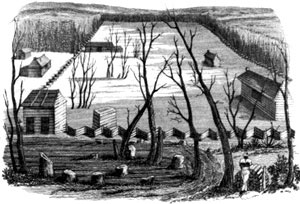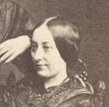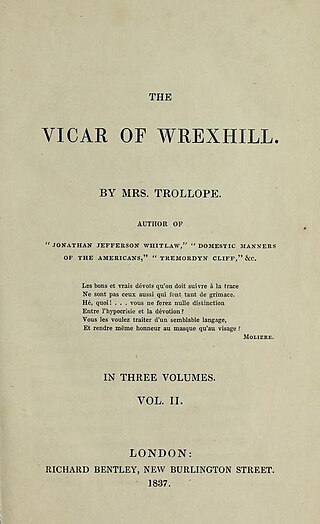
Frances Wright, widely known as Fanny Wright, was a Scottish-born lecturer, writer, freethinker, feminist, utopian socialist, abolitionist, social reformer, and Epicurean philosopher, who became a US citizen in 1825. The same year, she founded the Nashoba Commune in Tennessee as a utopian community to demonstrate how to prepare slaves for eventual emancipation, but the project lasted only five years.

Anna Brownell Jameson was an Anglo-Irish art historian whose work spanned art and literary criticism, philosophy, travel writing, and feminism. She became very well known for her extensive writings. Jameson was connected to some of the most prominent names of the period including Joanna Baillie, Fanny Kemble, Elizabeth Barrett-Browning and Robert Browning, Harriet Martineau, Ottilie von Goethe, Lady Byron, Harriet Hosmer, Ada Lovelace, Charles and Elizabeth Eastlake, and Barbara Leigh Smith Bodichon.

Lydia Maria Child was an American abolitionist, women's rights activist, Native American rights activist, novelist, journalist, and opponent of American expansionism. Her journals, both fiction and domestic manuals, reached wide audiences from the 1820s through the 1850s. At times she shocked her audience as she tried to take on issues of both male dominance and white supremacy in some of her stories.

Thomas Corwin, also known as Tom Corwin, The Wagon Boy, and Black Tom was a politician from the state of Ohio. He represented Ohio in both houses of Congress and served as the 15th governor of Ohio and the 20th Secretary of the Treasury. After affiliating with the Whig Party, he joined the Republican Party in the 1850s. Corwin is best known for his sponsorship of the proposed Corwin Amendment, which was presented in an unsuccessful attempt to avoid the oncoming American Civil War.

Frances Milton Trollope, also known as Fanny Trollope, was an English novelist who wrote as Mrs. Trollope or Mrs. Frances Trollope. Her book, Domestic Manners of the Americans (1832), observations from a trip to the United States, is the best known.

The Nashoba Community was an experimental project of Frances "Fanny" Wright, initiated in 1825 to educate and emancipate slaves. It was located in a 2,000-acre (8 km2) woodland on the side of present-day Germantown, Tennessee, a Memphis suburb, along the Wolf River. It was a small-scale test of her full-compensation emancipation plan in which no slaveholders would lose money for emancipating slaves. Instead, Wright proposed that, through a system of unified labor, the slaves would buy their freedom and then be transported to Haiti or the settlements which would become Liberia.

The Bowery Theatre was a playhouse on the Bowery in the Lower East Side of Manhattan, New York City. Although it was founded by rich families to compete with the upscale Park Theatre, the Bowery saw its most successful period under the populist, pro-American management of Thomas Hamblin in the 1830s and 1840s. By the 1850s, the theatre came to cater to immigrant groups such as the Irish, Germans, and Chinese. It burned down four times in 17 years, a fire in 1929 destroying it for good. Although the theatre's name changed several times, it was generally referred to as the "Bowery Theatre".
Maria W. Stewart was an American teacher, journalist, abolitionist and lecturer known for her role in the anti-slavery and women's rights movements in the United States. The first known American woman to speak to a mixed audience of men and women, white and black, she was also the first African American woman to make public lectures, as well as to lecture about women's rights and make a public speech opposing slavery.

John Milton Bernhisel was an American physician, politician, and early member of the Latter Day Saint movement. He was a close friend and companion to both Joseph Smith and Brigham Young. Bernhisel was the original delegate of the Utah Territory in the United States House of Representatives and acted as a member of the Council of Fifty of the Church of Jesus Christ of Latter-day Saints.
Nationality words link to articles with information on the nation's poetry or literature.

Thomas Adolphus Trollope was an English writer who was the author of more than 60 books. He lived most of his life in Italy creating a renowned villa in Florence with his first wife, Theodosia, and later another centre of British society in Rome with his second wife, the novelist Frances Eleanor Trollope. His mother, brother and both wives were known as writers. He was awarded the Order of Saints Maurice and Lazarus by Victor Emmanuel II of Italy.

Perley Poore Sheehan was an American film writer, novelist and film director. He was once married to Virginia Point (1902-unknown). Sheehan also wrote detective and adventure fiction for the pulp magazines. Sheehan wrote two fantasy novels, The Abyss of Wonders (1915), about a lost civilization in the Gobi Desert, and The Red Road to Shamballah (1932–1933) about a hero with a Tibetan magic sword.
The American Senator is a novel written in 1875 by Anthony Trollope. Although not one of Trollope's better-known works, it is notable for its depictions of rural English life and for its many detailed fox hunting scenes. In its anti-heroine, Arabella Trefoil, it presents a scathing but ultimately sympathetic portrayal of a woman who has abandoned virtually all scruples in her quest for a husband. Through the eponymous Senator, Trollope offers comments on the irrational aspects of English life.

Moving Day was a tradition in New York City dating back to colonial times and lasting until after World War II. On February 1, sometimes known as "Rent Day", landlords would give notice to their tenants what the new rent would be after the end of the quarter, and the tenants would spend good-weather days in the early spring searching for new houses and the best deals. On May 1, all leases in the city expired simultaneously at 9:00 am, causing thousands of people to change their residences, all at the same time.

This is a bibliography of the works of Frances Trollope.

The Boston Atlas (1832–1857) newspaper of Boston, Massachusetts, was published in daily and semi-weekly editions in the mid-19th century. John H. Eastburn established the paper in 1832. Editors included Richard Hildreth, Richard Haughton, William Hayden, Thomas M. Brewer, William Schouler, R. Carter. Among the contributors: Joseph Carter Abbott, Benjamin Perley Poore, Samuel F. Tappan. Its office stood at no.18 State Street and later in the Old State House. The paper supported the Whig Party. Its Democratic rival, with which it sparred constantly, was The Boston Post. In 1857 the Boston Traveller absorbed The Atlas.

Frances Eleanor Trollope was an English novelist. She was best known for her biography on her mother-in-law, Frances Milton Trollope, who was famous for her book, Domestic Manners of the Americans, as well as her novels.

Pamela A. Neville-Sington was an American literary biographer and authority on the life and works of Fanny Trollope, Anthony Trollope, and Robert Browning.
Abolitionist children’s literature includes works written for children by authors committed to the movement to end slavery. It aimed to instill in young readers an understanding of slavery, racial hierarchies, sympathy for the enslaved, and a desire for emancipation. A variety of literary forms were used by abolitionist children’s authors including, short stories, poems, songs, nursery rhymes and dialogues, much of it written by white women. Pamphlets, picture books and periodicals were the primary forms of abolitionist children’s literature, often using Biblical themes to reinforce the wickedness of slavery. Abolitionist children's literature was countered with pro-slavery material aimed at children, which attempting to depict slavery as a noble pursuit, and slaves as stupid and grateful, or evil.

The Vicar of Wrexhill is an 1837 novel by the British writer Frances Milton Trollope, originally published in three volumes. The High Church Anglican Trollope was heavily critical of the Evangelical movement. It has been described as a "scurrilous" critique of Low church Evangelical Anglicanism, often referred to in the novel as Calvinist Doctrine. It is Frances Milton Trollope's best remembered novel, with the protagonist resembling Mr Slope in her son Anthony Trollop's Barchester Towers.















